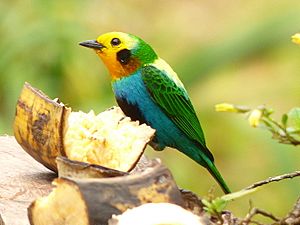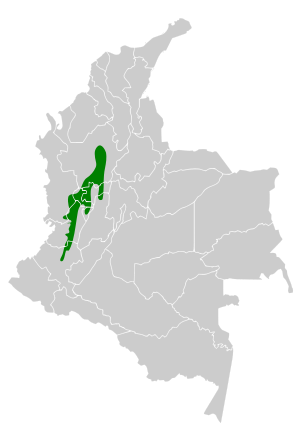Multicoloured tanager facts for kids
Quick facts for kids Multicoloured tanager |
|
|---|---|
 |
|
| Conservation status | |
| Scientific classification | |
| Genus: |
Chlorochrysa
|
| Species: |
nitidissima
|
 |
|
The multicoloured tanager (Chlorochrysa nitidissima) is a very colourful bird that lives only in the mountains of Colombia. It belongs to the Thraupidae family, which includes many types of tanagers.
This beautiful bird is currently listed as a vulnerable species by the IUCN. This means its population is decreasing, and it needs protection to survive in the wild.
Contents
What it Looks Like
The multicoloured tanager is a small passerine bird, which means it's a perching bird. It's about 12 cm (5 inches) long, which is roughly the size of a small sparrow.
Male tanagers are very striking! They have:
- A bright yellow crown, face, and throat.
- Chestnut and black patches around their ears.
- Shiny green feathers on their neck and wings.
- A lovely blue colour on their rump, chest, and belly.
- A black patch in the middle of their underside.
Female tanagers are a bit less colourful than the males. They don't have the yellow on their back or the black patch on their belly. Young birds of both sexes look similar to the females, but their colours are even duller.
Why it's Called That
The scientific name of this bird tells us a lot about its appearance:
- The genus name Chlorochrysa comes from Greek words meaning "bright green" and "yellow." This perfectly describes the bright green and yellow parts of its feathers.
- The species name nitidissima is Latin for "very bright" or "most shining." This refers to how beautiful and vibrant its feathers are.
Where it Lives and Its Home
The multicoloured tanager lives only in the wet mountain forests of the Occidental and Central mountain ranges in Colombia. It is an endemic species, meaning it's found nowhere else in the world.
These birds usually live at high altitudes, mostly between 1300 and 2200 meters (about 4,200 to 7,200 feet) above sea level. However, some have been seen as low as 900 meters (about 3,000 feet).
You can find them in several Colombian regions, including:
They seem to prefer old, untouched forests. But they can also be found in forests that are growing back or on the edges of forests. Many recent sightings have been in the Valle del Cauca Department, where they live all year round, even in small forest areas.
What it Eats
Multicoloured tanagers are often seen flying with mixed groups of other bird species. They usually look for food high up in the treetops.
They mostly search for insects on the underside of leaves, holding onto the leaves with their feet. They also enjoy eating ripe fruits, especially from plants like Cordia, Miconia, Palicourea, and Ficus.
Reproduction and Life Cycle
Scientists don't have a lot of detailed information about the breeding habits of the multicoloured tanager. Most of what we know comes from individual observations.
Here are some things that have been seen:
- Young birds have been spotted with adults in November and January.
- Adults were seen feeding chicks in August.
- Juvenile birds (young birds) have been observed eating fruit with adults in January.
- More young birds were seen with adults in February and March.
These observations suggest that multicoloured tanagers might breed for a long period, from November to August. This is a common pattern for birds that live in tropical areas all year.
Protecting the Multicoloured Tanager
The multicoloured tanager is listed as vulnerable because it lives in a small area and is found in only a few places. It used to be more common, but its numbers have dropped.
The biggest threat to this bird is the loss and breaking up of its forest home. About 81% of its habitat has already been destroyed. This is mainly due to:
- Logging (cutting down trees).
- Mining.
- Agriculture (farming).
- New human settlements.
- New roads, which make it easier for people to access and change the forests.
Studies show that this bird is very sensitive to its habitat being broken into smaller pieces. It's much more likely to be found in large, continuous forests than in small forest fragments.
Even though the bird lives in some protected areas like Farallones de Cali, Munchique, and Los Nevados National Parks, many recent sightings are in unprotected private forests.
To help protect the multicoloured tanager, here are some ideas:
- Create more and larger protected areas where they live.
- Make sure conservation rules are followed in existing protected areas.
- Help local communities find ways to live that don't harm the forests.
- Do more scientific research to find out how many birds are left and what they need to survive.
In the Valle del Cauca department, where many tanagers are found, efforts are being made. This area has changed a lot due to farming and ranching. However, two Important Bird Areas (Chicoral and San Antonio) have been created, raising awareness about bird conservation. These areas connect to Los Farallones National Park, a very large protected area. Several local conservation groups also work there, especially by teaching local communities about protecting the environment.
See also
 In Spanish: Tangara multicolor para niños
In Spanish: Tangara multicolor para niños


